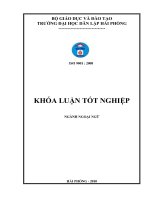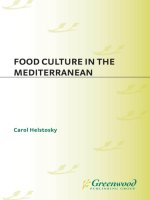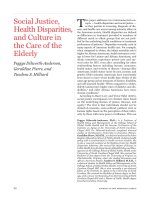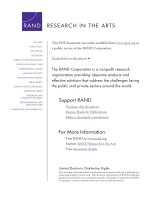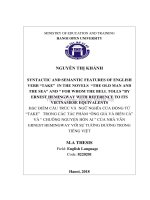Lao culture in the novel
Bạn đang xem bản rút gọn của tài liệu. Xem và tải ngay bản đầy đủ của tài liệu tại đây (206.59 KB, 6 trang )
No.10_Dec2018|Số 10 – Tháng 12 năm 2018|p.68-73
TẠP CHÍ KHOA HỌC ĐẠI HỌC TÂN TRÀO
ISSN: 2354 - 1431
/>
Lao culture in the novel "Plains of jars" by Trinh Thanh Phong
Tran Thi Le Thanha*
a
Tan Trao University
Email:
*
Article info
Abstract
Recieved:
09/11//2018
Accepted:
10/12/2018
Trinh Thanh Phong is one of the typical writers of prose in Tuyen Quang. At the
age of sixty five, he has not only contributed much good writing such as novels,
poems and stories, for Tuyen Quang literature in particular and Vietnamese
literature in general, but also has won awards abroad. “Land at Plains of Jars” is
a novel which got Dong Duong Award in the Mekong River Literature Prizes.
These were the friendship prizes among Vietnam, Laos and Cambodia awarded
in Phnom Penh city in 2008. This paper addresses issues concerning the cachet
of Laos culture (especially in friendship between Laos and Vietnam), base on the
novel “Plains of Jars”..
Keywords:
Trinh Thanh Phong's
novel; Chum field land;
Lao cultural imprint
1. Trinh Thanh Phong - Life and Career
1.1. About his life
Trinh Thanh Phong (Penname: Hai Thanh) was
born on February 20th, 1950 in Phu Chinh Village, Vinh
Tuong, Lap Thanh, Vinh Phuc, however, he was grown
up in Thong Village, Lam Xuyen Commune, Son
Duong District, Tuyen Quang.
Until now, there is no document to show about his
family class. Many people base on his works to have
their own assessments. The question about his family
position and class still remained unanswered if the
works named “Ngay tho dai” (Childhood Days) was not
created. In his works, writer Trinh Thanh Phong opened
every pages of his life to the readers. Through the pages
of this works, he described about the hard days when he
spent his childhood with rivers, rice fields, with buffalo
and the plow, with hard days and familiar village
customs. The story he told about his grandmother was
so touched which helped the readers to understand
deeply his family position and class: “My grandma was
born in Phu Vinh Tuong. Her father was a teacher and
her mother was a farmer. When she was a girl, she
followed other farmers to this place ….she went to seek
for shelter”[1]. He was proud of his grandma as he was
68
proud of his hometown. He was grown up and lived
with that pride because he was deeply aware that “the
secrets from blends in the clothes as well as the
saltiness in the tears from my grandma’s eyes dropping
into the rice fields in the early morning that day!....
Then, it was also so honorable to him for the days
he was trying very hard for his career. When he was at
high school, the boy of 18 years old was excited to join
the army. In the first days, Trinh Thanh Phong was at
the battlefield in Laos. This was the time for the writer
to accumulate the practical experience about the
soldiers and the daily life. Especially, he had the
opportunity to approach the culture (Lao Culture)
which was of long tradition and quite developed in his
opinion. In difficult living conditions at the battlefield
with his fellow comrades who faced the death
everyday, Trinh Thanh Phong deeply felt and
understood the camaraderie with his Lao friends.
Suffering from losses, sacrifices, the extraordinary
efforts paid by him and his Lao friends became the
valuable capital for the writer to shown in his works
later.
After Paris Agreement was signed (1973), the writer
Trinh Thanh Phong could continue his high school
T.T.L.Thanh / No.10_Dec 2018|p.68-73
education at Military Culture School (Lang Son) which
was later upgraded in Logistics Institute. At the end of
1976, because of his poor health conditions and
“karma” (as he said), he applied for discharging from
military service to work at Department of Culture and
Information of Ha Tuyen.
From 1998 until 2008, writer Trinh Thanh Phong
was nominated to hold the position of chairman
Literature and Art Association in Tuyen Quang cum
Editor-in-Chief of Tan Trao Newspaper. Now, he was
retired and still continues writing the pages full with
humanistic spirit.
1.2. Career
Writer Trinh Thanh Phong has many works printed
on the central and local newspapers since 1980s,
however, until 1990s, these works were officially
published and introduced to the readers with the first
short stories in the collection of short stories named Bai
Cuoi Song (The alluvial Plain at the end of River).
Since then, he has published more than ten books with
hundreds of works: Gap Lai (See Again) (Collection of
Short Stories. Cultural and National Publishing House,
1998); Doi Mat Vang Trang (The Eyes and the Moon)
(Collection of Poems - Association of Letters and Arts
of Tuyen Quang, 1999); Loi Ru Ban Mai (Morning
Lullabies) (Collection of Short Stories - Cultural and
National Publishing House, 2000); Ma Lang (Village
Ghost) (Novel - Writers Association Publishing House,
2002); Buc Tuong Xanh (Green Wall) (Collection of
Stories - Kim Dong Publishing House, 2003); Duoi
Chan Nui Bac Quan (Under Bac Quang Mountain Foot)
(Collection, Cultural and National Publishing House,
2006); Dong Lang Dom Dom (Village Field and
Firefly) (Novel, Literature Publishing House, 2010);
Hien Ra Tu Huyen Thoai (Born from the Legend)
(Collection, Cultural and National Publishing House,
2010); Dat Canh Dong Chum (Plains of Jars) (Novel,
Writers Association Publishing House, 2007); Ong
Manh Ve Lang (Deceased bachelor comes back village)
(Novel, Literature Publishing House, 2009); Mien Sang
(Collection of Short Stories, People’s Army Publishing
House, 2015); Trinh Thanh Phong Novel (Writers
Association Publishing House, 2014); Ngay Tho Dai
(Days of Childhood) (Long storey, Kim Dong
Publishing House, 2014).
In addition, he also has many works printed on Tan
Trao Newspaper, Van Nghe Newspaper, People’s
Army Magazine etc. since 1970 to date and some works
selected to post in Tuyen Quang Poems and Literature
1999-2004 and Collection of 20 years of Tuyen Quang
Literature, collections of selected short stories of
Vietnam Writers' Association etc…
2. Beauty of Lao Culture
2.1. Summary on Laos
In terms of population, Laos is a thinly-populated
country (the population of more than 6 million
people/236,800 km2). The population is stretching
throughout the country through different geographical
locations with many typical cultural features. Laos has
more than 60 ethnic groups in which the majority is
from three main ethnic groups of Lao Lum (belonging
to Lao-Thai language group with the population of
about 2 million people, accounting for 70% of Laos’s
population) who are mainly living in low areas mainly
including valleys and river deltas along rivers; Lao
Thong people (belonging to Mon-Khowme language
group) mainly live in the midlands. Compared to other
groups, this is the local population group living for
longest time in Laos; Lao Xung people (belonging to
Han Tang language group) mainly live in temperate
highland in the North and Central Laos. This group of
people mainly lives on the nature with simple farming
techniques, therefore, the economic conditions are
generally lower than other groups.
In terms of history, since XIVth Century, Laos had
recorded their official history when the feudal state with
centralized power was formed by King Fa Ngum in
1353. Basing on the archaeological evidences, Lao
society in the pre-history period was developed from
clans, tribes to the primitive communalism respecting to
the development from Paleolithic, Neolithic, Bronze to
Iron Age.
Since XIVth Century to XIXth Century, Lao
feudalism had developed through many dynasties such
as King Fa Ngum, King Setthathilat; King Xulinha
Vongxa etc. In 1893, French Colonialism agreed and
cut the right bank of Mekong River for Siam to govern
and the left bank of Mekong River belonged to the
French Colonialism. In 1930, the The Communist Party
of Indochina (former name of The Lao People's
Revolutionary Party) was formed to lead the people of
Laos to fight against the French Colonialism. In 1945,
Laos declared the independence on October 12th. Same
as Vietnam, the peace did not last long, the American
Empire invaded Laos. And in 1955, The Lao People's
Revolutionary Party was formed to directly lead the
69
T.T.L.Thanh / No.10_Dec 2018|p.68-73
resistance war against the United States. With the
supports from other countries in the world, especially
Vietnam, on December 2nd, 1975, Lao Revolution won
completely and the Lao people has enjoyed the peace
until now.
In terms of organizational structure, Laos society
was formed early with village unions (Xieng in Lao
language) and then developed into ancient towns.
Ancient towns had existed to form and develop the
tradition and cultural identity of Laos. Many intangible
and tangible cultural heritages of Laos are still
preserved to witness the cultural life of Lao people in
these ancient towns. It is a pity that Laos was annexed
by Siam in the XVIIth Century which destroyed
seriously Lao culture.
2.2. The beauty of Lao Culture
Similar to many other neighboring countries in
Southeast Asia (especially Vietnam), Laos is a country
with long-aged and quite developed culture. As a flow
of fresh water continuously from this generation to
another generation, Lao culture has created the soul,
spirit and traits of Lao identity. Through the periods of
history, Lao culture has been existed together with the
diversified customs, habits, religions, and beliefs.
The first beauty in Lao culture should be customs
and habits closely linked to the unique traditional
festivals. Well-known as the country with festivals all
year round, Laos celebrates its traditional festivals in
very special and different way of Lao people. As almost
other countries in Southeast Asia, Lao festivals includes
main New Year festivals (Solar New Year, Lunar New
Year (as in some other Asian countries), Lao New Year
(Bun PiMay in April) and H'mong New Year (in
December) and many other festivals in the whole year
such as Bun Phavet (Buddha reincarnation) in January;
Bun
VisakhaPuya (Vesak)
in
April; Bun
BangPhay (squib) in May; Bun Khao PhanSa (Lent) in
July; Bun Khao Padapdin (in memory of the deceased)
in September; Bun Suanghua (boat race) in October etc.
Only basing on the names and spirits of the
Festivals in Laos, it can be seen that in terms of culture,
Laos is a Buddhist country. Buddhist was passed into
Laos since 7th Century and has become the state religion
since 14th century. With the population of more than 6
million people, there are more than 5 million people
(accounting for more than 90% of population) have
special respects to the Buddha, Buddhist scriptures and
monks in the temples. Therefore, Laos built 1,400 big
70
and small pagodas with the typical cultural, historical
and architecture values to become the places for
worshiping the Buddha and the places where the
tourists can visit. Many cultural activities of Lao people
have deep imprints of Buddhist culture. Temples are
closely linked to schools, the life of Buddhists at home.
Especially, since the Buddha is the state religion, Laos
people consider that ethnical standards in the Buddhist
scriptures as the ethnical standards that the whole
society should follow. It is easy to find out that Lao
people are often compassionate, gentle and willing to
share and support each other.
In addition to religion, belief and traditional
festivals, it often talks about the symbol of the country
and people of Laos - that is the symbol of Champa
flower. This symbol shows and reflects clearly the
national culture, identity and soul of Lao people. That is
a peaceful country with the quiet, gentle and simple
people who are willing to sacrifice for their nation.
Finally, when talking about the beauty that creates
the culture of the Land of a Million Elephants, the
country of Champa flower, it should mention about the
interesting and amazing natural landscapes and relics
such as That Luong (Vientiane), Luang Prabang ancient
town (the world cultural heritage), Vatxixun temple,
Phu Xi mountain, mysterious plains of jars
(Xiengkhuang), Khone Falls, Kuang Si Falls, Tham
Ting cave etc. which all together create the imprint of
Buddhist culture which cannot be mixed with any other
countries in Southeast Asia.
Talking about the mysterious beauty of Plains of
jars, it is the well-known place that everyone who once
visits the land of a Million Elephants should not forget.
For Vietnamese people, the name of Plains of Jars is
very familiar too. The legends about Plains of Jars had
followed the Vietnamese soldiers when they were in
Laos. However, we can only feel fully its beauty and
the cultural values hidden in these valuable cultural
heritages when we can see the plains with our own eyes
and touch the stone jars with our own hands and listen
to the legends about the formation of stone jars. Plains
of Jars has become the cultural and historical address
and a famous tourism destination throughout the world
of this Land of A Million Elephants.
2.3. Vietnam-Laos Friendship
Vietnam and Laos are two neighboring countries
with the close relationship which has been formed and
strengthened through thousands of years of country
T.T.L.Thanh / No.10_Dec 2018|p.68-73
construction and keeping. The beautiful relationship
between two nations have been built and strengthened
by President Ho Chi Minh and President Kaysone
Phomvihane and many generations of leaders of the
parties and people of two countries. Looking back the
history, we are so proud of the special and valuable
relationship between two nations. In the war against the
old colonialism, two countries formed Vietnam-Laos
troops to together fight against our shared enemy. The
first Vietnamese voluntary soldiers came to Laos to
together with Pathet Lao soldiers to protect the beautiful
country of Laos. The close cooperation of two nations,
the determination and sacrifice for the beautiful
friendship had resulted in the glorious victory for two
countries in the resistance war with the signing of
Genève 1954 Agreement on Indochina.
In the war against the neocolonialism - American
Empire, the solidarity between Vietnam and Laos had
become even deeper. On September 5th, 1962, Vietnam
and Laos officially established the diplomatic
relationship to open a new phase in the history of two
countries. The union troops of two countries of
Vietnam and Laos defeated many wicked conspiracies
of the enemy. The relationship between the people in
Vietnam-Laos border has been strengthened. The
mighty Truong Son Mountain Range with two halves of
Eastern Truong Son and Western Truong Son had
become the dynamic image for that relationship. The
solidarity of Vietnamese and Lao people in the hard but
glorious years had contributed considerably to help the
people and armed forced of two countries to go from
this victory to anther victory. Spring 1975 Great
Victory in Vietnam and Victory on December 2nd 1975
in Laos was the result of extraordinary efforts and
revolutionary achievements of two nations.
3. Novel Plains of Jars from cultural view
Trinh Thanh Phong is the author of the Novel Plains
of Jars which helps him to become the owner of
Indochina Prize - Mekong River Literature Prize about
the friendship between three countries of Vietnam,
Laos, Cambodia in 2008. This novel shows deeply the
cultural beauty and spiritual life of the soldiers in the
friendship relationship of Vietnam-Laos in the war. As
said by Author Nguyen Van Thuyet: “the author
awarded with Mekong Literature Prize (Cambodia,
Laos, Vietnam) is really worthy for his talent,
battlefield experience of the writer himself and the
sacrifice of this comrades [3 - page 126].
The novel does not focus on building an ideal
example, a typical characteristics or a story core with
many complicated and sudden situations around the
main character etc. it tells about the Vietnamese
soldiers in the relationship with Lao soldiers, Lao
people in the hard days of the war on the Plains of Jars
in Xiengkhuang province. Through the pieces of the
war, the beauty of the soul and portraits of Lao soldiers
and people are clearly presented in every single page.
Once joining the voluntary troops in Laos, and
experiencing the hard days of the war, more than
anyone else, Trinh Thanh Phong fully and deeply felt
and understood the characteristics of Lao people and
the beauty of their souls. In communication, Lao people
are very sentiment and hospitable. For every
relationship, Lao people are very close, sincere and
tolerate. In the life, Lao people are very gentle, honest
and simple. In job, Lao people attach much importance
on honor. Worshipping the Buddha and being
influenced by the moral thought of Buddhism, Lao
people are willing to help the people in need and
difficult situations etc. In addition to the twinning
procedures, Lao people consider those who spend hard
times with them as brothers and sisters. In Plains of
Jars, writer Trinh Thanh Phong spent many pages to
describe these characteristics of Lao people. The
uprightness, honesty and extremely tolerance of Pho
Dum were described by the writer with the beauty of
appearance and the soul. The way of thinking of Pho
Dum about the war was very simple but he inevitably
believed in the final victory: "Village is too simple! All
beautiful houses were destroyed by the enemy. But
bombs of the enemy could only collapse the houses but
land. We have land, we have everything!. The enemy
gone, we will build beautiful and big houses". The
feeling of Pho Dum to Lao soldiers, Vietnamese
soldiers and Lao people are also very deep: "You have
gone for a week, Pho comes this tunnel every afternoon
to tidy up and looks at the cloud on Phu Nhu mountain
and feels so anxious. Pho can be only happy when you
are all at home” ”[2 - page 43]. Pho Dum's expectation
and wish about the war are really respectable: "We have
to fight a big battle to liberate Laos, Bua Van will hide
the big gun into the mountain and bring books and pens
to the children in Na Khum to go to school to learn. The
people in Na Khum hamlet will plant rice, maize and
build beautiful and big houses. At night, Lam Vong will
be extended to Khang Khay Street. Girls and boys in
the hamlet will sing and dance with Vietnamese
71
T.T.L.Thanh / No.10_Dec 2018|p.68-73
soldiers. It must be so cheerful to drink wine with
Vietnamese soldiers. Pho Dum's face is brightened with
hopes"[2 - page 44]. The pure and extremely exquisite
beauty of Bua Van, Bua Khan and the solid faith and
will of Thao Sun, Kham Din etc. were also shown
convincingly by writer Trinh Thanh Phong. The way of
thinking of Can in Plains of Jars is also the way of
thinking of many Vietnamese people when living
together with Lao people: " Lao people are supported
with the back as firm as copper wall because of people
like Pho Dum, Bua Van, Bua Khan, Thao Sun, Kham
Din etc. with the faithfulness to the resistance war. This
lights up the trust that "The American people cannot be
the winner of this war regardless of modern weapons
and elite troops that they have [2 - page 46]. The pride
of Can and the confidence full with sincere affection
from the heart with Lao people were also shown in
moved way through this words to his mother "I am
under the ground at Phu He Mountain. The ground here
is very warm and solid. The ground is as the souls of
Lao mothers! Lao people and Lao country are wholehearted to protect us just like you. I am very happy
because Bua Van tied a red thread into my hand! Mom,
that red thread has much special meaning. The Buddha
is in this thread to tie this fate between me and Bua
Van! [2 - page 56].
Having its own traditional cultural characteristics,
Vietnamese and Lao people have many things in
common because of originated from the agricultural
culture. “Through every pages of Plains of Jars, we can
see the names, and lives of Vietnamese people and Lao
people alternatively who shared the same fighting
72
trench, were at the same battlefield for the shared
determination of defeating the enemy” [4 - page 126] .
In addition to giving the good impression about the
beautiful friendship and the beauty of Lao people,
Plains of Jars is also deeply influenced by the Lao
culture, culture of Plains of Jars with the special and
unique customs, by the names of locations, villages
which are closely linked to the memory about the war
time. The image of Pho Dum who passed the empty
bowls of wine and the melody of “in every singing
words, there are the perfume and beauty that are
crystallized from the mountains, from the forest of this
mysterious and simple land - Land of a Million
Elephants! The singing voice and the twinkle hands
under the moonlight which is full in the eyes to lift up
the moon to fly with the dews following the dancing
and following the dancing hands” [2 -page 52] will be
deeply in the hearts of two countries of Vietnam and
Laos forever.
REFERENCES
1. Trinh Thanh Phong (2014), Childhood Days, Long
story, Kim Dong Publishing House.
2. Trinh Thanh Phong (2007), Plains of Jars, Novel,
Writers Association Publishing House.
3. Nguyen Van Thuyet (2009), Reading Novel Plains of
Jars by Trinh Thanh Phong, some feelings, Tan Trao
Newspaper , Edition No. 49 - 1st Period in May 2009.
4. Tran Huy Van (2013), Plains of Jars - The love song
about Vietnam-Laos Battle, Tuyen Quang Literature in
Innovation Period (1986 - 2006) - Works and
Comments, Thai Nguyen University Publishing House.
T.T.L.Thanh / No.10_Dec 2018|p.68-73
Dấu ấn văn hóa Lào trong tiểu thuyết “Đất cánh đồng chum” của Trịnh Thanh Phong
Trần Thị Lệ Thanh
Thông tin bài viết
Ngày nhận bài:
09/11//2018
Ngày duyệt đăng:
10/12/2018
Từ khoá:
Tiểu thuyết Trịnh Thanh
Phong; Đất cánh đồng
Chum; Dấu ấn văn hóa
Lào.
Tóm tắt
Nhà văn Trịnh Thanh Phong là một trong những cây bút tiêu biểu của nền văn xuôi
Tuyên Quang thời kỳ Đổi mới. Ông thuộc thế hệ nhà văn trưởng thành sau 1980 và
đặc biệt có nhiều thành tựu vào những năm đầu của thế kỷ XXI. Với 65 năm tuổi đời
và ngót 40 năm cầm bút, ông không chỉ đóng góp cho nền văn học Tuyên Quang nói
riêng, văn học Việt Nam nói chung về số lượng các tác phẩm (bao gồm đủ các thể
loại tiểu thuyết, truyện ngắn, bút ký, thơ…) mà còn đóng góp nhiều tác phẩm có chất
lượng, được ghi nhận bởi nhiều giải thưởng lớn trong và ngoài nước. Đất cánh đồng
chum là cuốn tiểu thuyết đã nhận được giải thưởng Đông Dương – Giải thưởng văn
học Sông Mêkông. Đây là giải thưởng về tình hữu nghị ba nước Việt Nam, Lào,
Campuchia tại PhNôm Pênh năm 2008. Bài viết, trên cơ sở khái quát một vài nét về
cuộc đời, văn nghiệp của Trịnh Thanh Phong và nét đẹp của văn hóa Lào, từ đó chỉ
ra những nét văn hóa Lào đặc sắc trong tiểu thuyết Đất cánh đồng Chum.
73


